| |
Bacterial Ring Rot of Potato - Some Key Questions | |
| |
|
|
| |
|
|
| | What causes ring rot? | Where did the infection come from? | How does one get rid of ring rot? | What to expect from ring rot testing? | The lab tests
What Causes Ring Rot?
Ring rot is caused by a bacterium:
- its properties differ significantly from fungi and viruses.
- many fungi can be controlled by chemical sprays, bacteria generally cannot.
- many viruses can be controlled by controlling their vectors, bacteria cannot.
Bacteria are very small:
- A great many ring rot bacterial cells are present in even a very small infection.
- Ring rot bacteria can be spread about readily.
- The extent that ring rot has spread by the time it is detected is difficult to know.
Ring rot bacteria as seen with a scanning electron microscope.
Bacteria are persistent:
- Under the right conditions ring rot bacteria persist for many years.
- Ring rot bacteria survive in infected potato plant and tuber tissue - wherever they may be.
- Ring rot bacteria survive particularly well under dry or cold conditions.
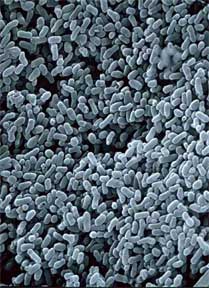
Ring rot bacteria as seen with a scanning
electron microscope
Where Did the Infection Come From?
There are two possible sources:
- It came from an off-farm source.
- It persists at a low level on the farm site.
Off-farm sources of ring rot:
- Infected seed potatoes bought from another farm.
- Infected culls brought on-site as cattle feed.
- Un-cleaned commercial trucks or other contaminated equipment brought on farm.
- By man or animals from neighbouring, infected tablestock or processing crops.
Persistence on farm site:
- Insufficient clean-up after ring rot occurrence - gradually builds up again - spread by equipment.
- Maintenance of a low level of infection (latent) on farm - short generation time - flush through but back infection - spread by equipment.
How Does One Get Rid of Ring Rot?
Getting rid of ring rot:
- TOTAL clean up.
- Remove ALL potatoes from operation.
- "Flush-through system" do not keep seed on farm for several years subsequent to BRR.
- Clean all potentially contaminated surfaces.
- Disinfect completely all cleaned surfaces.
- Get rid of, or sterilize, all potentially contaminated disposables eg. gloves, knives, overalls, etc.
Finding ring rot on a farm:
- Visual inspection - limited sensitivity due to latent infections, success varies with variety and growing conditions.
- Lab tests - better sensitivity than visual, but still limited sensitivity due to sample size and test factors.
Underlying assumption in determining probability of detection:
- Ring rot is randomly distributed in a lot; each plant is equally likely to be infected.
- Is the assumption more true for small lots than it is for big lots ?????
Some reasons for non-randomness of ring rot:
- One lot planted with seed from different sources.
- Different equipment was used for harvesting, planting, etc. of a portion of the lot
- Seed stored in different places.
- One lot planted in different fields.
- Seed lot grown adjacent to non-seed field.
- Low incidence of BRR, seed cutters inoculates adjacent seed -NOT RANDOM.
What to Expect from Ring Rot Testing
Greatest limitation is sample size:
Sample size | Disease incidence | Probability of detection |
400 | 0.1% | 33% |
1000 | 0.1% | 63% |
2000 | 0.1% | 86% |
5000 | 0.1% | 99% |
What can testing do?
- Testing CANNOT prove that a potato lot is free from ring rot.
- Testing is an extension of visual inspection.
- Testing sensitivity is limited by sample size and the laboratory test.
- Positive test result indicates, with a high level of certainty, that ring rot is present.
- Negative test result indicates that the level of infection is below detection level.
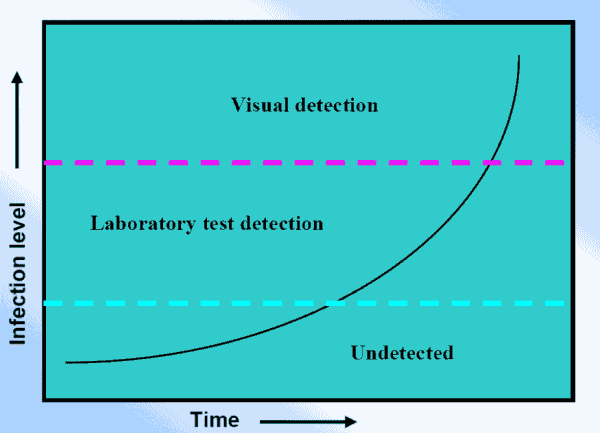
The Lab Tests
- ELISA - tests for presence of slime produced by the bacteria.
- IMF - tests for the presence of cells of the ring rot bacterium.
- PCR - tests for the presence of DNA of the ring rot bacterium.
ELISA Test
- Excellent screening test.
- Subject to false positives.
- Sensitivity limited by testing in composite samples.
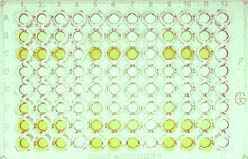
.
IMF
- Eliminates false positives of ELISA and confirms true positives.
- Discerns typical bacterium cell structure.
- Indicates level of infection in the plant or tuber.
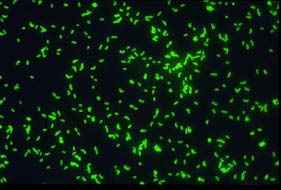
.
PCR
- Extremely sensitive.
- Risk of contaminating sample from infected neighbouring lot.
- It’s a tricky test prone to test problems.
- Costly do do.
- Patent-protected method.
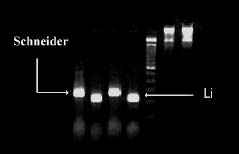
.
Sensitivity of lab tests:
- Sensitivity is decreased by testing in composites.
- Sensitivity is decreased by using a positive/negative threshold to avoid false positive results.
- In addition to the nature of the test, sensitivity is affected by sample concentration, dilution, and volume of sample extract actual used in the test.
CFIA Testing Strategy
Positive test result:
- Err on the side of caution.
- A positive is only called when there is no doubt.
- This approach prevents a false BRR diagnosis.
- This approach favors the seller over the buyer.
- Negative test result:
- Can never be certain that there is no BRR infection below test sensitivity or outside of sampled units.
Solke H. De Boer
CFIA - Lab Directorate |
|
| |
|
|
| |
For more information about the content of this document, contact Robert Spencer.
This information published to the web on December 3, 2003.
Last Reviewed/Revised on December 10, 2012.
|
|